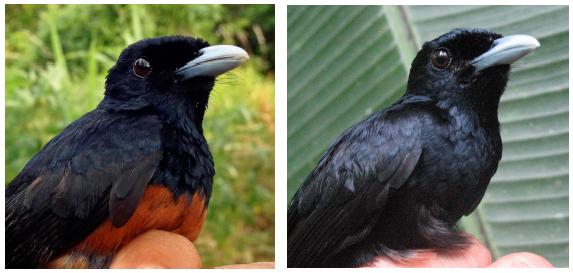Dark plumage helps birds survive on small islands

This image shows a typical Chestnut-bellied Monarch (left) vs. a melanic individual (right). Credit: A. Uy
One less-studied pattern of evolution on islands is the tendency for animal populations to develop “melanism”–that is, dark or black coloration. J. Albert Uy and Luis Vargas-Castro of the University of Miami found an ideal species to study this phenomenon in the Chestnut-bellied Monarch (Monarcha castaneiventris), a bird found in the Solomon Islands.
Most have the chestnut belly suggested by their name, but in the subspecies found in the Russell Islands, a few all-black birds coexist with the chestnut-bellied majority. After visiting 13 islands of varying sizes to survey their Chestnut-bellied Monarch populations, Uy and Vargas-Castro confirm in a new paper published this week in The Auk: Ornithological Advances that island size predicts the frequency of melanic birds, with populations on smaller islands including more dark individuals.
Because the pattern is repeated on island after island, it is very unlikely to have developed through random chance; instead, dark coloration must provide some sort of benefit to birds on small islands.
Studies in mammals and fish have found a genetic link between melanism and aggressive behavior, and Uy and Vargas-Castro speculate that the limited space available on smaller islands makes competition for breeding territories more intense, giving an advantage to the most aggressive individuals.
Previous experiments with other Monarcha castaneiventris subspecies using taxidermied birds and recorded songs have shown that melanic birds react more aggressively than their chestnut-bellied counterparts when they perceive a threat to their territory.
Uy had been fascinated by Chestnut-bellied Monarchs ever since reading a description of their plumage variations in Ernst Mayr's seminal book on speciation, Systematics and the Origin of Species from a Viewpoint of a Zoologist, when he was a graduate student.
“I was hooked and longed to work on the group,” he says. “I thought this would be the perfect species to explore these questions about the ecology of plumage diversification and the origin of species, as the variable populations of the chestnut-bellied flycatcher may be at different stages of the speciation process. It took me over a decade to finally manage to get to the Solomons, and I've been working on these flycatchers now for nearly 10 years.”
“Patterns of biodiversity on islands have always been important for understanding fundamental principals in ecology and evolution. Using the same archipelago that enchanted Ernst Mayr decades ago, Uy and Vargas-Castro reveal fascinating patterns of melanism and island size,” adds Rebecca Safran of the University of Colorado, an expert on divergence between bird populations who was not involved in the study. “These patterns add to the fundamental importance of islands as natural experiments for studies in biodiversity.”
“Island size predicts the frequency of melanic birds in the color-polymorphic flycatcher Monarcha castaneiventris of the Solomon Islands” is available at http://www.
About the journal: The Auk: Ornithological Advances is a peer-reviewed, international journal of ornithology that began in 1884 as the official publication of the American Ornithologists' Union. In 2009, The Auk was honored as one of the 100 most influential journals of biology and medicine over the past 100 years.
Media Contact
All latest news from the category: Life Sciences and Chemistry
Articles and reports from the Life Sciences and chemistry area deal with applied and basic research into modern biology, chemistry and human medicine.
Valuable information can be found on a range of life sciences fields including bacteriology, biochemistry, bionics, bioinformatics, biophysics, biotechnology, genetics, geobotany, human biology, marine biology, microbiology, molecular biology, cellular biology, zoology, bioinorganic chemistry, microchemistry and environmental chemistry.
Newest articles

First-of-its-kind study uses remote sensing to monitor plastic debris in rivers and lakes
Remote sensing creates a cost-effective solution to monitoring plastic pollution. A first-of-its-kind study from researchers at the University of Minnesota Twin Cities shows how remote sensing can help monitor and…

Laser-based artificial neuron mimics nerve cell functions at lightning speed
With a processing speed a billion times faster than nature, chip-based laser neuron could help advance AI tasks such as pattern recognition and sequence prediction. Researchers have developed a laser-based…

Optimising the processing of plastic waste
Just one look in the yellow bin reveals a colourful jumble of different types of plastic. However, the purer and more uniform plastic waste is, the easier it is to…



